Abstract
This study investigates the evolution and prospective directions of big data applications within the global digital economy over the past twelve years. A comprehensive bibliometric analysis was conducted using Biblioshiny and included 752 documents authored by 1748 scholars and published in 416 specialized journals and academic books between 2013 and 2024. The findings reveal that scholarly interest in this area peaked in 2024. Co-occurrence network mapping highlights three dominant thematic trends in the applicability of big data within the digital economy: technological innovations, conceptual frameworks, and the role of China. Influential academic publications—such as Sustainability, PLoS ONE, and the proceedings of the 8th International Conference on Information Technology and Quantitative Management—have played a pivotal role in advancing research in this domain. Moreover, leading institutions, including the University of the Chinese Academy of Sciences, Shenzhen University, and Guizhou University, have emerged as pivotal contributors to advancing research in this field. China is the primary driving force and key player in reshaping the digital economy through big data, a role that is expected to contribute to global technological advancement in the future.
1. Introduction
Big data is revolutionizing industries, reshaping global markets, and redefining business strategies. By unlocking the potential of vast datasets, companies can drive innovation, enhance decision-making, and create more personalized experiences. From predictive analytics to AI-driven insights, the digital economy is evolving at an unprecedented pace—but with transformation comes new challenges. How can businesses harness big data effectively, and what hurdles must they overcome to ensure ethical, sustainable growth? Big data has emerged as a fundamental pillar of the contemporary digital economy, serving as a catalyst for innovation, operational efficiency, and the evolution of new business paradigms. The exponential growth of data generation across diverse sectors underscores its transformative potential, enabling organizations to refine strategic decision-making processes and enhance consumer engagement through data-driven insights. As businesses progressively integrate big data into their operational frameworks, interdisciplinary specialists—including data scientists, economists, and policymakers—are increasingly invested in optimizing its utility while addressing critical concerns related to security, ethical data governance, and equitable accessibility. The digital economy is fundamentally sustained by vast and continuous streams of data originating from online transactions, social media interactions, interconnected devices, and cloud-based infrastructures. Organizations employ advanced analytics, artificial intelligence (AI), and machine learning methodologies to process and derive actionable insights from these extensive datasets. The implications of big data integration are multifaceted and transformative, and they are optimizing business strategies, improving decision-making, and enhancing operational efficiency.
The integration of big data analytics has profoundly reshaped multiple sectors, fostering innovation and efficiency across diverse domains. These advancements are particularly evident in finance, healthcare, retail, and urban development, where data-driven insights enable more precise forecasting, improved service personalization, and optimized infrastructure management. With the expansion of artificial intelligence and the Internet of Things (IoT), big data has become the essential asset that stimulates efficiency, innovation, and competitive advantage—all of which are necessary for economic growth and business success [1]. Its ability to process and analyze datasets has allowed organizations to identify trends, predict consumer behavior, and improve decision-making processes. The applicability of big data is recognized in many fields. Several implications of big data in different domains are known, and they are being highlighted by bibliometric studies and other studies by specialists. The most significant of these are in the following fields: (1) education and higher education [2,3]; (2) healthcare and medicine [4,5]; (3) finance and banking [6,7]; (4) management or business [8,9,10]; (5) forestry [11]; (6) librarianship [12]; (7) e-commerce and marketing [13,14]; (8) transportation and smart cities [15,16,17].
The most important aspects of big data have also been reflected in other bibliometric studies by specialists who have focused on (1) the evolution of big data [18,19], (2) the big data revolution [20], and (3) big data trends [21,22,23]. Specialists have also conducted bibliometric studies over significant time periods in an attempt to capture the evolution of big data as best as possible. These studies were carried out over the following time periods: (1) 1993–2021 [24]; (2) 2008–2018 [25]; (3) 2009–2018 [26]; (4) 2014–2018 [27]. Certain databases were used for investigation, such as Scopus in the period of 2009–2019 [28] or Web of Science in the period of 2011–2023 [20].
The implications of big data have been highlighted by specialists and through studies related to (1) the potential of big data in value creation and capture [29], (2) the interdisciplinary nature of big data [30], (3) combining ethics with big data [31], and (4) big data and supply chain management [32]. Unlike the concept of big data, the concept of the digital economy has been debated under various aspects in bibliometric studies by specialists in relation to (1) the digital economy based on big data—artificial and computational intelligence [33]; (2) the evolution of the digital economy [34] during the period of 1992–2022 [35]; (3) big data in the digital economy [36]; (4) social, legal, and economic aspects of the development of big data in a digital economy [37]; and (5) the trend in the EU [38].
Given the significant expansion of the scholarly literature on big data in recent years, it has become imperative to synthesize its applications and implications within the digital economy, particularly against the backdrop of the profound digital transformations characterizing recent periods. Accordingly, the main objective of this article is to present a meta-study examining the technological evolution of big data over the past twelve years (2013–2024) and to identify emerging trends that are expected to shape its trajectory in the future. This study provides a comprehensive review of academic publications that explore the global applicability and broader economic implications of big data within the digital economy over the specified timeframe. In pursuit of the main objective, two research questions have been formulated, the responses to which will serve as the foundation for deriving conclusions pertinent to the subject under investigation. These research questions (RQs) are as follows: RQ1: How has scientific research on the applicability of big data in the digital economy evolved in structural, intellectual, and social terms between 2013 and 2024? RQ2: What are the keywords, emerging trends, and critical concepts associated with this field of study?
This study makes the following significant contributions to filling some gaps in the specialized literature: (1) covering the synthesis gap of the evolution of academic publications regarding the implications of big data in the digital economy worldwide; (2) analyzing the performance and scientific mapping of the conceptual evolution and expansion of big data in the digital economy in academia through the prism of bibliometric indicators; (3) identifying the motivations and future research directions regarding the application of big data in the digital economy worldwide.
Section 2 provides an overview of previous studies on big data in the digital economy, establishing the rationale for the present analysis. Section 3 outlines the methodology used in this study. The fourth section presents the discussion and findings, highlighting the conclusions of the descriptive, relational, and content-based analysis. In Section 5, the conclusions summarize this study’s main contributions, its limitations, and directions for future research.
2. Materials and Methods
To examine the applicability and implications of big data within the digital economy, a systematic literature review (SLR) was conducted, facilitating the identification of answers to the formulated research questions. As the volume of scientific publications continues to expand, the integration of quantitative bibliometric techniques has become essential for processing and analyzing extensive datasets. These methodologies enable researchers and specialists to enhance scholarly communication, address increasingly complex research topics, and foster collaboration through bibliographic data. Consequently, they contribute to the advancement of literature reviews by refining scientific descriptions and evaluations.
A search was conducted in the Web of Science (WoS) database to identify relevant publications from 2013 to 2024, using the keyword combination “Big Data” and “Digital Economy”. The initial search retrieved 828 documents, encompassing book chapters, conference proceedings, and publications across multiple languages. To refine the selection, the filtering process restricted the dataset to peer-reviewed journal articles published in English within the disciplines of computer science, business, and management, ensuring the inclusion of pertinent research contributions. Following the screening and filtering procedures, a total of 752 documents were retained for analysis in this study. The methodology for searching, screening, inclusion, and exclusion of research documents is visually represented in Figure 1, adhering to the PRISMA protocol.
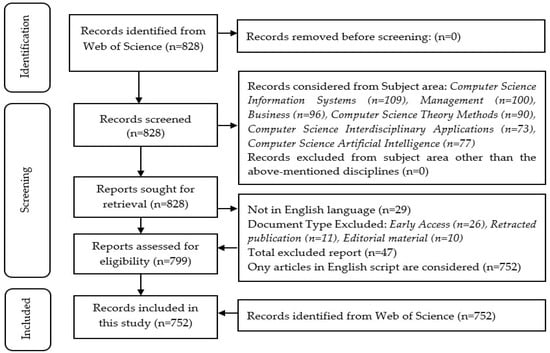
Figure 1.
Data description according to Prisma protocol.
After filtering the data, they were exported from Web of Science as BIB files, which were then imported into Biblioshiny, the interface for Bibliometrix. Biblioshiny is accessible to practitioners and supports a wide range of statistical approaches and visualizations. Bibliometrix provides various methods for conducting temporal or longitudinal analyses [39], as well as additional features such as the ability to generate simple line charts to display frequency variations, historiographic visualization, thematic mapping, and reference publication year spectroscopy [40]. Excel was used to enhance the visual quality of graphic representations and for specific statistical data processing alongside Biblioshiny. Table 1 presents the final dataset sample, highlighting the most relevant publications on the applicability of big data in the digital economy, including journal articles with a high impact factor and specialized books.

Table 1.
Data description.
An analytical framework (Figure 2) was established to systematically address the research questions, facilitating their interpretation through various types of analysis: descriptive, bibliometric and network, and thematic.
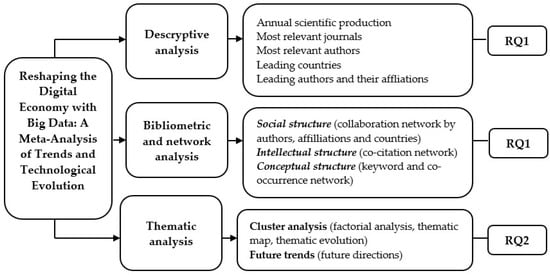
Figure 2.
Analytical framework of our study.
The set of bibliometric indicators used to perform the types of analyses indicated above are (1) annual scientific production (articles and citations); (2) the most relevant journals (journal production over time, the impact of local sources and their dynamics) and the most influential authors (the most cited authors globally and locally, co-authorship network, scientific production by country, and author affiliations); (3) social structure analysis (collaboration network by authors, affiliations, and countries); (4) intellectual structure analysis (the most cited documents globally and locally, bibliographic reference spectroscopy); (5) conceptual structure analysis (keyword co-occurrence network, word cloud, thematic map and thematic evolution, factor analysis).
3. Results
3.1. Annual Scientific Production
The information presented in Figure 3a reflects the number of articles published annually from 2013 to 2024. With 181 publications, 2024 was the most productive year for scientific article publications, followed by 2022, with 148 annual publications, and 2023, with 134 annual publications. A steady increase in scientific publications from 2019 to 2024, from 66 to 181 publications, can be observed. The high peak of the average annual citations was reached in 2017 (11.85), and the second peak was reached in 2023 (6.78). In the other years, the average annual citations were very low, with minimum values ranging between 0.75 (2014) and 5.06 (2022). From a graphical point of view, the situation of annual scientific production (Figure 3a) and average annual citations (Figure 3b) is presented below.
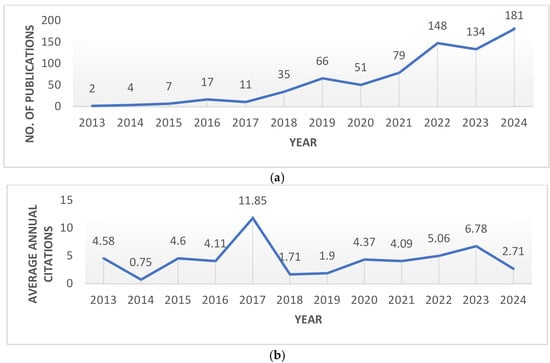
Figure 3.
(a) Annual scientific production. (b) Average annual citations.
3.2. The Most Relevant Journals and the Most Influential Authors
Figure 4 illustrates the temporal evolution of the top ten journals, ranked by the Hirsch index (H-index), which measures publication productivity and citation impact.
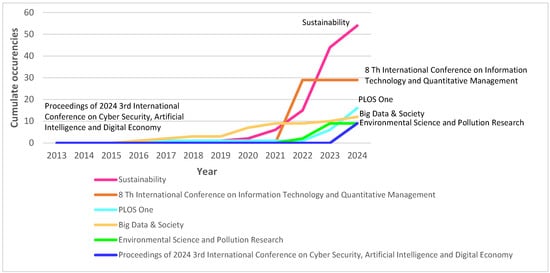
Figure 4.
Journals’ production over time.
Although the H-index measures an author’s performance within a specific field, it can also be applied across disciplines and journals to evaluate their impact. By using the H-index for a journal, we can assess its performance or significance. Among the top ten selected journals, Sustainability (123 publications), followed by the 8th International Conference on Information Technology and Quantitative Management (87 publications) and PLoS ONE (28 publications), exhibited the highest productivity in terms of published articles. The information base has been structured through a summary of data collected from the top three journals, as illustrated in Figure 4.
Top-tier journals act as gatekeepers of quality and innovation. They select the most rigorous peer-reviewed research, setting the standard for what is considered cutting-edge. When a concept or methodology appears in leading journals such as Sustainability or Big Data & Society, it gains visibility, credibility, and adhesion within the academic community. Table 2 outlines the local impact of these journals analyzed using the H-index (which evaluates productivity and citation impact), G-Index (which measures the influence of highly cited publications by accounting for the cumulative number of citations received by the most influential works), and M-Index (which assesses research impact relative to the number of years since the first publication). Local citations indicate how often a work is cited within a specific set of documents, as opposed to global impact, which reflects citations across the entire database. Additionally, Table 2 includes a report on the total citations received by the top ten journals. The ranking, determined by the total number of local publications, reinforces the dominant position of these three journals.

Table 2.
Impact of local journals.
Figure 5a–d visually represents the top ten most relevant journals based on impact, citations, and publication volume. According to the H-index (Figure 5a), Sustainability (15) holds the highest impact factor, followed by the 8th International Conference on Information Technology and Quantitative Management, Big Data & Society, Environmental Science and Pollution Research, and PLoS ONE, each with an impact factor of 8. Based on the G-Index (Figure 5b), the journals with the highest impact factors are Sustainability (25) and PLoS ONE (12). In terms of total citations (Figure 5c), the most cited journals in the field are PLoS ONE (857 citations), Sustainability (756 citations), and the Journal of Cleaner Production (712 citations).
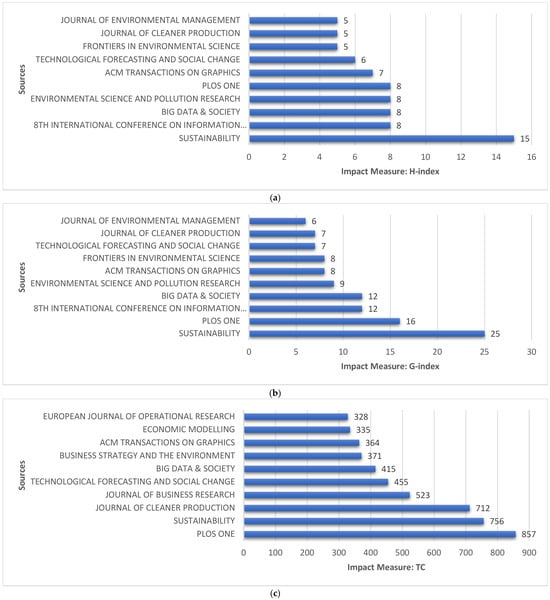
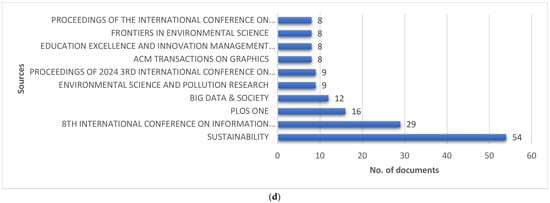
Figure 5.
Impact of local sources by (a) H-index. (b) G-Index. (c) number of total citations. (d) number of documents.
In terms of publication volume (Figure 5d), Sustainability is the most prolific journal, with 54 published articles. Sustainability ranks among the world’s top ten most indexed and cited journals, highlighting its significance and the presence of influential authors within its domain.
Figure 6a showcases the ten most prolific authors over time along with their H-index, an author-level metric designed to evaluate both the quantity of a researcher’s publications and the influence of citations on their work. The index comprises a set of publications by scientists that are most frequently referenced and how often these works have been cited in other works. The ranking was established based on the author’s H-index, unrelated to their authorship position—whether as the sole contributor or as a co-author within a multi-authored publication. Huang Hui ranks at the top of the list (Figure 6a) as the most cited author in the field of big data’s impact on the digital economy. Influential authors shape academic discourse through prolific output, high citation counts, and thought leadership. Their work often becomes foundational, steering research agendas and impacting policy decisions or industry practices. Figure 6b highlights the local impact of authors based on total citations (TC), with Doherty et al. emerging as the most cited authors among the top 20 analyzed authors, accumulating 750 citations. Doherty is part of a group of 16 co-authors who are all esteemed specialists affiliated with leading universities in the United Kingdom. Aiden Doherty, a globally recognized expert, holds affiliations with multiple prestigious institutions, including the Big Data Institute, the BHF Centre of Research Excellence, and the Institute of Biomedical Engineering within the Department of Engineering Science at the University of Oxford, United Kingdom.
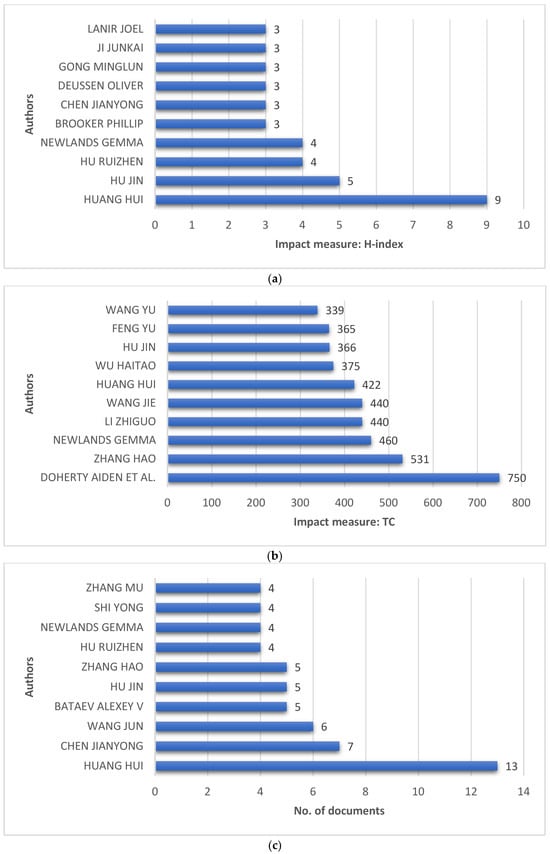
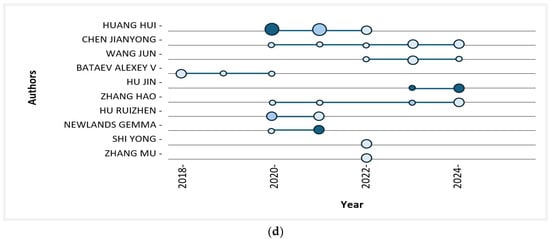
Figure 6.
(a) Most productive authors by H-index. (b) Most productive authors by total citations. (c) Article production of the top ten authors. (d) Authors’ production over time.
This citation distribution underscores the significance of collaboration and institutional networks in amplifying research impact within the field. This reflects the level of academic and professional recognition of specialists contributing to the advancement of technology, particularly big data in the digital economy. Figure 6c illustrates the distribution of total publications. Huang Hui was the most productive author, contributing 13 articles (0.50% of all publications), followed by Chen Jianyong, with 7 articles, and Wang Jun, with 6 articles. Figure 6d highlights the authors with the highest publication output from 2013 to 2024. The large dots represent the number of articles, while their spacing indicates the publication timeline.
Analyzing author productivity over time reveals the following publication patterns: Huang Hui (2020–2023) leads, with 13 articles, followed by Chen Jianyong (2020–2024), with 7 articles. Additionally, Wang Jun (2022–2024), Bataev Alexei V. (2018–2020), and Zhang Hao (2020–2024) each contributed five articles. These findings underscore the growing dedication of researchers to the study of big data’s role in the digital economy, reaffirming its status as a continuously evolving and highly relevant field of inquiry. Scientists form social networks through collaborative research, particularly by co-authoring scientific papers, which results in the creation of co-authorship networks. A field is defined by several fundamental concepts, including its key subtopics and associated patterns. The co-citation network of articles reveals the relationships between sources and their mutual influence.
Figure 7 presents an analysis of the co-authorship network among authors studying the application of big data in the digital economy. The network structure, based on the number of articles, highlights two distinct clusters: (1) the blue cluster, comprising the authors of [41,42,43,44,45] and their collaborators, and (2) the red cluster, consisting of multiple lesser-known authors, including [46,47,48,49]. These authors contribute significantly to the research landscape, strengthening collaborations and adding weight to their respective studies.
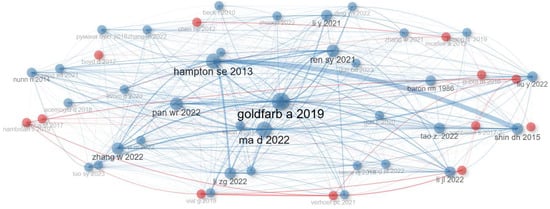
Figure 7.
Co-authorship network.
Figure 8a shows the results of the most cited countries. A total of 44 countries have contributed to research on the implications of big data in the digital economy. China ranks first, with 7140 citations. This shows that research conducted by researchers or institutions in China has a dramatic impact on the global scientific community. The United Kingdom is in second place, with 2103 citations, and the USA is in third place, with 800 citations, which also reflects a significant contribution to the field. Collectively, these three nations account for 10,043 citations, representing 74.68% of the global total of 13,447 citations on this subject. Countries such as Norway, Australia, France, Russia, Croatia, Brazil, India, Italy, Thailand, Portugal, Singapore, and Germany show also play a vital role in the scientific literature focused on the implications of big data in the digital economy.
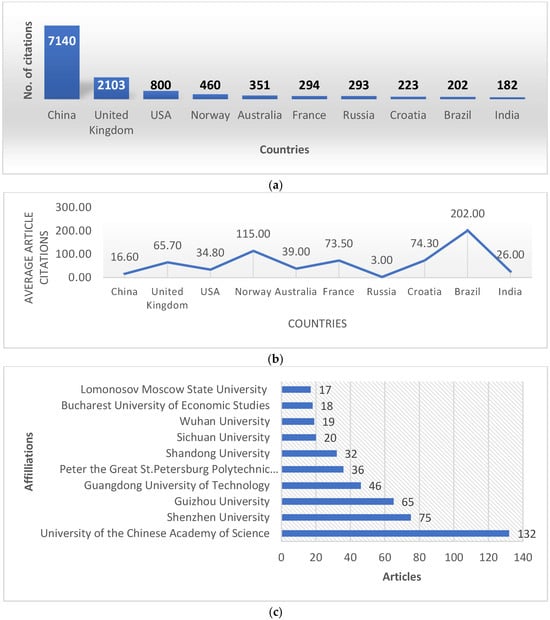
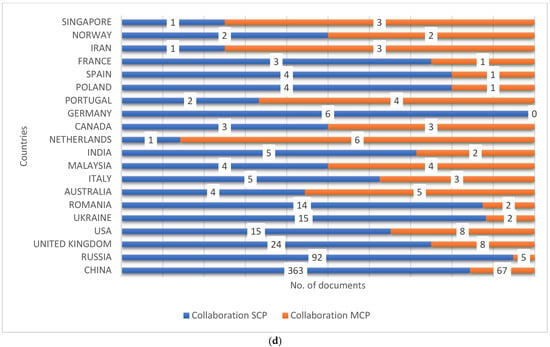
Figure 8.
(a) Most cited countries. (b) Average article citation on countries. (c) Most cited universities by author affiliation. (d) Authors’ countries of correspondence.
Additionally, Figure 8b presents various scenarios, highlighting the significant disparity between the total number of citations and the average citations per article. As described in the ranking of the top ten countries, China leads in total article citations (TCs), indicating that based on average quality, Chinese articles rank the highest, with 430 articles (57.20% of the total); however, the average citation rate is low (16.60) compared to Norway (115.00) or Brazil, which have the highest annual citation rates (202.00). The lowest citation rate in the production of scientific articles worldwide (97 articles or 12.9% of the total) is that of Russia (3.00). Some countries, such as India (AAC 26.00) or Australia (AAC 39.00), demonstrate an increasing average annual citation (AAC) rate although they have produced a small number of articles.
The data highlighted in Figure 8c are the most relevant affiliations for the contribution of the authors to the research work related to the topic addressed. Chinese universities lead the rankings in terms of author affiliation (Figure 8b), with the University of the Chinese Academy of Sciences at the forefront (132 articles), followed by Shenzhen University (75 articles) and Guizhou University (65 articles).
The University of the Chinese Academy of Sciences (UCAS) plays a crucial role in big data research, contributing to the development of the digital economy and advanced technologies. UCAS hosts the Key Laboratory of Data Mining and Knowledge Management under the Chinese Academy of Sciences, where researchers explore intelligent algorithms, computing platforms, and applications in the digital economy. Additionally, UCAS is actively involved in the International Research Center of Big Data for Sustainable Development Goals (CBAS), integrating digital technologies to monitor and assess global progress toward the United Nations Sustainable Development Goals (SDGs). This center develops data infrastructures, cloud services, and AI-driven solutions for large-scale data analysis. Through these initiatives, UCAS significantly advances big data research, shaping the digital economy, sustainability, and technological progress.
Shenzhen University is actively engaged in big data research, making a significant impact on the development of digital technologies and intelligent applications. One of its key research centers is the Shenzhen Research Institute of Big Data (SRIBD) that spearheads innovations in large-scale data processing and applications, aiming to develop disruptive technologies and attract leading experts in the field. Additionally, researchers in Shenzhen are exploring smart city platforms, where big data is leveraged for digital governance and urban infrastructure optimization. Through these initiatives, Shenzhen University plays a crucial role in advancing big data research, influencing areas such as artificial intelligence, data analytics, and digital transformation.
Figure 8d presents the distribution of publications by author affiliation and country of origin, differentiating between single-country publications (SCPs) and multi-country publications (MCPs). This distribution highlights how nations position themselves within the global research landscape and underscores the potential to enhance their scientific impact through expanded international partnerships. China leads with 430 articles, the majority being SCPs (363), while 67 are MCPs, indicating a preference for domestic research collaboration. Russia ranks second, contributing 97 publications, of which 92 are SCPs and five are MCPs, suggesting a similar reliance on national collaboration. In contrast, countries such as Canada, Norway, and Malaysia exhibit a balanced ratio between SCPs and MCPs. Meanwhile, Portugal and the Netherlands demonstrate a strong openness to international collaboration despite their relatively smaller contributions to global research. Notably, Germany is the only country in the ranking that does not engage in international collaborations. The analysis of corresponding author countries indicates that not all nations publish exclusively within their own borders (SCPs), reflecting national collaboration. Notably, countries such as Australia, Malaysia, and the Netherlands engage in multi-country publications (MCPs), showcasing international research partnerships. Given the complexity of the data, Figure 8d presents only the top twenty intra- and inter-country collaborations, highlighting significant global research networks.
3.3. Analysis of Social Structure
Figure 9a illustrates the social structure and collaborative networks among authors, and the thickness of the links visually represents the strength and thickness of the knots and the intensity of collaborations between authors.

Figure 9.
(a) Map of the authors’ network. (b) Map of the institutions’ network. (c) Map of the countries’ network.
Notable research collaborations include Network 1 (China–Israel), Huang Hui, Hu Ruizhen, Zhang Hao, Xie Ke, Lu Min, Gong Minglun, Xu Juzhan, Lanir Joel, and Cohen-Or Daniel; Network 2 (China), Huang Hui, Xiao Zhijiao, Lin Qiuzhen, Zhu Guangxu, Chen Jianyong, Zhong Shenghua, and Ji Junkai; and Network 3 (United Kingdom–Iraq–China), Silva Emmanuel Sirimal, Hassani Hossein, and Huang Xu. These collaborations highlight regional and international research partnerships, reflecting the interconnected nature of global scientific networks.
Figure 9b illustrates the social structure and institutional collaborations among authors, identifying eight distinct clusters, with three dominant groups.
- The first cluster consists of Chinese universities, including Shenzhen University, Guizhou University, Wuhan University, Guangdong University, Nanjing University, Xiamen University, and the Southwestern University of Finance and Economics.
- The second cluster also features leading Chinese institutions such as the University of the Chinese Academy of Sciences (UCAS), Beijing Union University, and Peking University.
- The third cluster represents an international collaboration between China, Singapore, and Bangladesh, involving Central University of Finance and Economics, Sichuan University, and Xi’an Jiaotong University alongside the National University of Singapore and SouthEast University.
The predominance of Chinese collaborations is evident at both the national and international levels. For instance, UCAS maintains strong partnerships with prestigious global universities such as Harvard University, Massachusetts Institute of Technology, Columbia University, Stanford University, and Cambridge University. Additionally, it collaborates with prominent research institutions, including the British Royal Academy of Sciences, French National Research Center, German Academic Exchange Center, and American Academy of Sciences. This distribution underscores China’s significant role in global academic networks, reflecting its extensive research collaborations and international outreach.
Figure 9c illustrates the social network and country-based affiliations of the authors, emphasizing China as the foremost contributor to both national and international collaborations, followed by the United Kingdom and the Netherlands. The thickness of the lines in the figure represents the strength of associations, with China demonstrating a strong commitment to global partnerships, particularly with the United States and the United Kingdom. Additionally, China is actively expanding collaborations with countries that belong to the Belt and Road Initiative (BRI), including those in Central Asia, the Middle East, and Africa, focusing on digital infrastructure projects and data analytics. These partnerships highlight China’s strategic efforts to enhance its global influence in digital technologies and further big data research through international cooperation.
3.4. Analysis of Intellectual Structure
Recognizing the key publications that have shaped the literature on big data’s role in the digital economy is essential for understanding the evolution of this research field. Likewise, examining citation trends provides valuable insights into its developmental trajectory. Our study identified 752 documents, which collectively garnered 13,447 citations, averaging 17.91 citations per document, with an annual citation growth rate of 19.52%. Table 3 highlights the fifteen most cited documents globally [50,51,52,53,54,55,56,57,58,59,60,61,62,63,64].

Table 3.
Top fifteen most cited articles globally.
The most influential work, receiving 750 citations, is Large-Scale Population Assessment of Physical Activity Using Wrist-Worn Accelerometers: The UK Biobank Study, published in PLoS ONE [50]. This study explores fluctuations in physical activity across various demographic factors—including age, sex, time of day, and season—offering critical insights into behavioral patterns. Leveraging sophisticated data collection techniques, it lays a foundation for further research into the health impacts of physical activity. The paper is a collaborative effort involving numerous specialists from universities across the United Kingdom. Among them, Doherty A. holds multiple affiliations, including (1) the Big Data Institute, Nuffield Department of Population Health, BHF Centre of Research Excellence, University of Oxford, United Kingdom, and (2) the Institute of Biomedical Engineering, Department of Engineering Science, University of Oxford, United Kingdom.
In Table 4, among the top fifteen most cited documents at the local level [34,51,53,60,63,65,66,67,68,69,70,71,72,73,74], two notable studies stand out. The first, authored by Dong F., is titled “How does the digital economy affect carbon emissions? Evidence from 60 countries worldwide,” published in the journal Science of the Total Environment.

Table 4.
Top fifteen most cited articles at local level.
The study empirically examines how the development of the digital economy influences carbon emissions and explores the underlying transmission mechanisms using the intermediary effect model for the period 2008–2018.
The second study, authored by Hu J., is titled “Synergistic effect of pollution reduction and carbon emission mitigation in the digital economy,” published in the Journal of Environmental Management. This paper empirically assesses the impact of establishing big data comprehensive experimental areas (BDCEAs) for air pollutants and carbon emissions, utilizing panel data from prefecture-level cities (2009–2020) and employing the time-varying difference-in-differences method. Both studies examine how the digital economy impacts carbon emissions and pollution, highlighting the role of digital transformations in environmental sustainability. Significant differences can be observed between local and global citations, indicating that research on the implications of big data for the digital economy is still evolving.
Local citations refer to the frequency with which an author or document within a collection is cited by other contributors within the same set. Regarding the most frequently cited local references [41,42,43,45,46,48,51,58,75,76,77,78,79,80,81] in Figure 10a, the top position is held by [41] from the Journal of Economic Literature (46 citations), followed by [43] from the Journal of Business Research (34 citations) and [75], also from the Journal of Business Research (31 citations). The difference in citation counts between the first and the other two authors is minimal. Reference publication year spectroscopy (RPYS) is a bibliometric method used to identify the historical roots and key landmark papers in a research field. By analyzing cited references in academic publications, RPYS determines which years and studies have had the greatest impact on a given topic. Figure 10b shows that the 752 analyzed documents contain 30,789 references comprising 13,447 citations, with a peak citation count in 2022 (3515 citations). According to the processed data, two key years are noticeable in the development of big data within the digital economy. The year 2022, which saw the highest citation peak (3515 citations), was marked by the publication of three influential articles by authors [43,75,77]. These studies examine how the digital economy drives productivity growth and high-quality economic development through innovation and entrepreneurship.
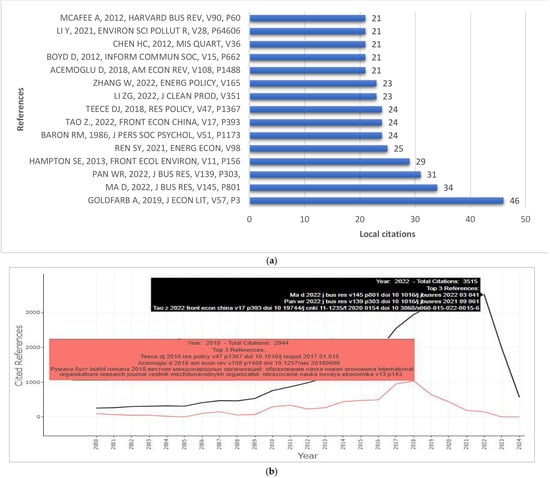
Figure 10.
(a) Top ten most cited citations locally. (b) Annual reference spectroscopy (RPYS).
Another significant reference year is 2018. Although its citation count (2944) is lower compared to other reference years in the graph, it remains notable for its contribution of three specialized works by authors [78,79,82]. These studies provide a complementary perspective on the digital economy’s role in shaping innovation, economic growth, and labor market structures. Employing econometric methods and empirical analyses, these articles assess the digital economy’s impact on various aspects of economic development and sustainability. These findings indicate that research on big data’s role in the digital economy follows a deliberate citation strategy, consistently referencing earlier, well-established studies.
3.5. Conceptual Structure Analysis
To gain deeper insights into the most significant terms in our dataset, we analyze 2540 keywords alongside a metric generated by the Biblioshiny package. This metric identifies words or phrases frequently appearing in the titles of article references but absent from the article title itself. These keywords help researchers uncover key themes, emerging trends, dominant paradigms, and shifting research priorities. In the context of bibliometric mapping, KeyWords Plus outperforms author keywords in relevance, though it is less effective for content analysis. Figure 11a presents the ten most relevant keywords, with “big data” leading, at 155 occurrences, followed by “innovation”, with 75 occurrences, and “impact”, appearing 57 times. The frequent use of these three keywords in specialist searches indicates their prominence among researchers, enhances the understanding of common terms, and helps refine searches for relevant studies. Additionally, they reveal relationships between different topics, show how they evolve over time, and allow researchers to track keyword frequency across different periods to highlight emerging research directions.
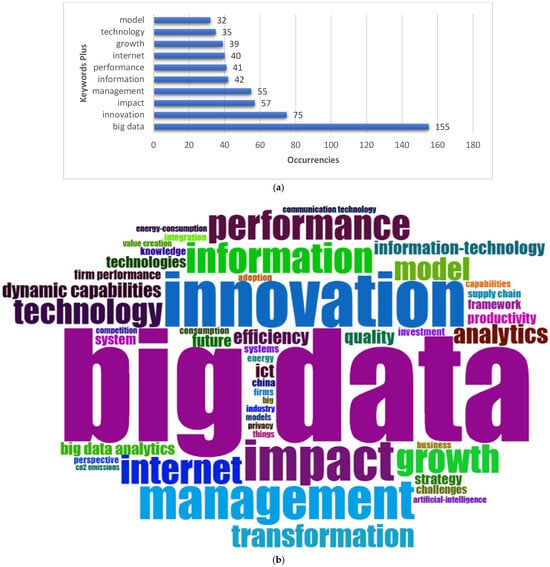
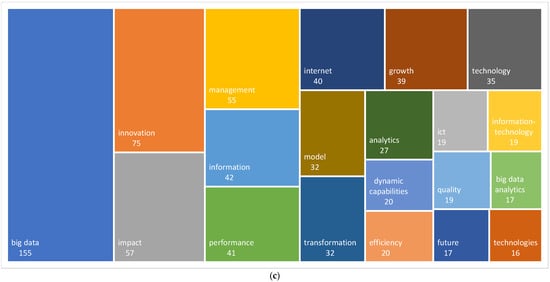
Figure 11.
(a) Top ten most relevant keywords. (b) Reference publication year spectroscopy (RPYS). (b) Author’s word cloud. (c) A treemap of KeyWord Plus terms.
Figure 11b illustrates the author’s keyword cloud on the implications of big data for the digital economy between 2013 and 2024. This visualization highlights terms with higher frequency and keyword density, with larger font sizes reflecting their prominence in scientific indexing. The keyword cloud also reveals how often these terms appear alongside other sources, authors, and articles, making it an engaging way to present information. The most prominent keywords, based on intensity and emphasis, align with those highlighted in Figure 11a.
A treemap is a visual tool used to represent the hierarchy and distribution of bibliometric data and to identify the most influential keywords in our dataset. The size of each rectangle reflects a keyword’s frequency or impact, allowing for an intuitive ranking based on their relative proportions. Figure 11c presents a treemap illustrating the analysis of 20 primary “KeyWords Plus” terms. KeyWords Plus terms consist of words and phrases extracted from the titles of cited articles, and they serve as a tool for identifying keywords and comparing their origins. Unique to WoS, Keywords Plus terms play a crucial role in extracting content and scientific concepts conveyed in academic publications.
From a hierarchical perspective and based on the frequency of keyword occurrences presented in Figure 11a,b, the level of interest among specialists is highlighted using the following colors: blue (big data—155 occurrences, 22%), orange (innovation–75 occurrences, 11%), grey (impact—57 occurrences, 8%), and yellow (management—55 occurrences, 8%) (Figure 11c).
4. Discussion
4.1. General Findings and Trends Regarding the Application of Big Data in the Global Digital Economy
After presenting the indicators in the previous section, we now offer a concise overview of the results. These findings contribute to the broader body of the literature and provide valuable insights for researchers and professionals interested in bibliometric data, supporting the development of future studies. Our analysis examined contributions from the most cited journals, authors, articles, institutions, countries, and keywords at both global and local scales. The results reveal a growing interest in the impact of big data, demonstrated by increased relevance, citation counts, and publication volume. This trend is further underscored by the notable rise in articles and citations between 2013 and 2024.
The bibliometric analysis indicates a growing trend in publications on this topic since 2016. Notably, a significant increase in publications has been observed since 2019, likely driven by the global pandemic (24.63% of the total publications). During this period, organizations across all sectors were compelled to adopt digital innovation and shift toward cloud-based business models—developments that provided both academics and practitioners with broader perspectives for exploring this subject. Notably, several of these contributions originate from institutions in developing countries such as Romania, Spain, Poland, India, Malaysia, Italy, and Australia. Furthermore, citation trends mirror the trajectory of scientific output at the article level—a pattern underscored by the bibliographic reference analysis presented in the previous section and the evolution of the H-index over time for journals and authors. Currently, China leads in citations, publications, and both national and international collaborations, positioning itself as the global frontrunner in big data research within the digital economy, followed by the United Kingdom and USA. The citation network analysis suggests that the study cited as [50] holds the highest number of global citations (750), followed by [51], with 440 citations. At the local level, [54] and [65] received the most citations.
The findings also indicate that countries such as China, the United Kingdom, and the United States make significant contributions to leading academic journals in this field, such as Sustainability, PLoS ONE, and the 8th International Conference on Information Technology and Quantitative Management. Similarly, notable academic institutions, particularly those based in China—such as the University of the Chinese Academy of Sciences, Shenzhen University, Guizhou University, Wuhan University, Guangdong University, Nanjing University, Xiamen University, and the Southwestern University of Finance and Economics—play a key role in advancing research in this domain. Additionally, the most advanced economies—such as those of China, Russia, the United States, and the United Kingdom, as well as those of developing countries such as Ukraine and Romania—frequently collaborate on big data research within the global digital economy. This collaboration is evidenced by ongoing research and development (R&D) initiatives and the substantial revenues generated from these activities.
Certain academic journals play a pivotal role in shaping research on big data’s implications for the digital economy. The Journal of Cleaner Production (4.22% of total citations), Sustainability (4.03%), Technological Forecasting and Social Change (3.84%), and the Journal of Business Research (3.60%) are the four most cited sources worldwide, collectively accounting for 15.69% of total citations. Regarding authorship, the most published articles belong to Huang Hui (0.50% of all articles), followed by Chen J. (0.27%), and Wang J. (0.23%). Considering the arguments outlined in this subsection, we conclude that RQ1 has been comprehensively answered.
Figure 12a illustrates research trends on big data’s implications for the digital economy from 2013 to 2024, encompassing institutions, journals, and countries. Our analysis reveals that while most research is conducted collaboratively, involving multiple authors, single-author articles still constitute the largest share of total publications. However, there is a noticeable rise in academic collaborations, reflecting a broader trend toward interdisciplinary research. This increasing global collaboration among researchers enhances specialization, deepens expertise, expands funding opportunities, and facilitates a more efficient division of labor, ultimately contributing to the advancement of the field.
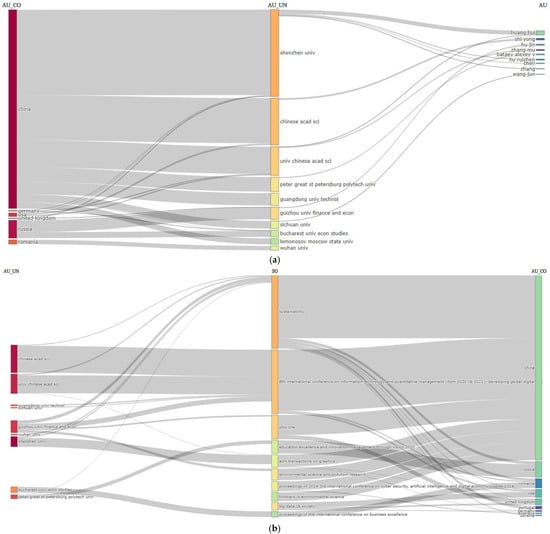
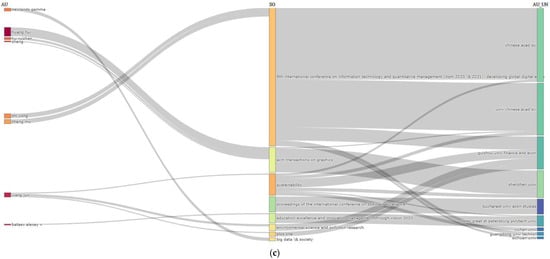
Figure 12.
(a) Three-field plots among countries (AU_COs), institutions (AU_UNs), and authors (AUs). (b) Annual reference spectroscopy (RPYS). (b) Three-field plots among institutions (AU_UNs), sources (SOs), and countries (AU-COs). (c). Three-field plots among authors (AUs), sources (SOs), and affilliations (AU_UNs).
Figure 12b illustrates the connections between institutions, journals, and countries, providing valuable insights into these collaborative networks. China ranks highest in citations and influential publications within this research domain. Studies on big data’s impact on the digital economy are predominantly published in journals such as Sustainability and PLoS ONE, as well as conferences like the 8th International Conference on Information Technology and Quantitative Management.
Figure 12c further explores interactions among journals, institutions, and contributing authors, highlighting China and Russia as the countries with the most active researchers producing high-quality papers.
4.2. Conceptual Structure: Factorial Analysis of Keywords and Thematic Evolution
The Biblioshiny interface for bibliometric analysis supports multiple correspondence analysis (MCA), a crucial method for constructing the conceptual framework of our subject area—the implications of big data in the global digital economy—by representing data as points in a low-dimensional Euclidean space. This multivariate exploratory technique identifies patterns among categorical variables through graphical and numerical analysis, facilitating the discovery of new latent factors. In this study, we employed MCA for co-word analysis. Figure 13 illustrates co-word network maps based on Keywords Plus authors, interpreting results according to word proximity and dispersion within dimensions—closer words exhibit greater similarity in distribution. Dimension 1 is the axis that accounts for the largest portion of the total variation. The variable categories positioned far from the origin along this axis contribute significantly to distinguishing authors based on their keywords. Dimension 2 accounts for the second-largest share of variation, independently of Dimension 1. Together, Dimensions 1 and 2 form a two-dimensional plane that allows for visualizing the relationships between keywords and authors. The MCA results, shown in Figure 13, reveal four clusters, with three dominant ones containing their respective variables, structured across two dimensions (Dim 1: 31.88%, and Dim 2: 16%). In this abstract representation, words function as parameters. These clusters encapsulate key aspects of big data’s impact on the digital economy. Topics nearer to the center received more attention, whereas those positioned further away indicate either lesser focus or a broader deviation from the core subject. The clusters are formed based on simple distance measurements, representing the degree of similarity between abstract terms.
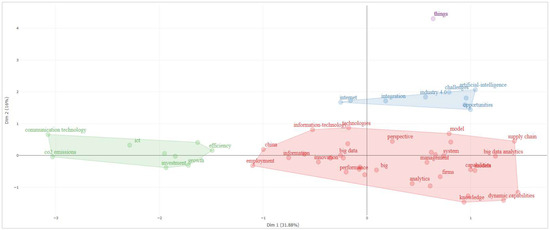
Figure 13.
Factor analysis of KeyWords Plus using multiple correspondence analysis (MCA).
The approach to the origin or the intersection of the two axes in the red cluster groups together a larger number of variables or keywords associated with the implications of big data in the digital economy, represented by keywords including Big Data, Big Data Analytics, technologies, information, management, perspective, and model. The proximity of these terms indicates that research the author’s articles commonly analyze them together. The green cluster consists of grouped elements that highlight the most significant components associated with big data, such as investment and growth. The distance between these terms indicates that most of the research articles are linked through them.
Similarly, the blue cluster, particularly at its edges, contains keywords related to big data in the digital economy, including artificial intelligence, opportunities, and challenges, thereby indicating scholarly connectivity among researchers engaged in this thematic domain. A distinct fourth cluster, labeled things (purple), appears separate from the others suggesting the presence of a group of researchers whose work diverges significantly from the central themes explored in the main area of current research.
To explore the inter-relationships among various research components and subthemes, we utilized a dendrogram. This method enables the classification of attractive variables into distinct clusters, each addressing different aspects of big data’s implications in the digital economy. Figure 14 illustrates the evolution of this research topic over time and highlights potential future directions. The tree-based thematic dendrogram effectively illustrates the hierarchical separation of three primary groups, defining their dimensions and assessing the functionality and diversity of variables within each cluster. The Y-axis represents branch height, indicating the proximity of data points or clusters to one another. At the first level, core elements related to big data’s implications are arranged based on their association strength. This distinct separation of dimensions highlights significant differences between terms. The further a branch extends, the more distinct and distant its corresponding group. This visualization reinforces this study’s conclusions on dimensionality and thematic classification.
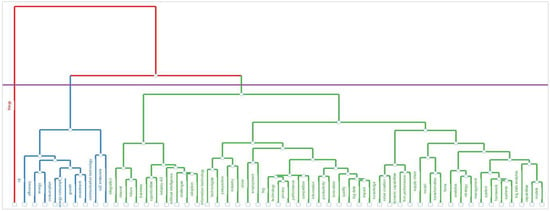
Figure 14.
Topic tree dendrogram.
The topic dendrogram tree presented here visualizes the most frequently used topics, their relationships with other subjects, and their classification through distinct colors.
Dendrogram representations are widely applied in various analytical contexts. This diagram categorizes topics into three classifications—red, green, and blue—each further subdivided into clusters and sub-clusters. These divisions illustrate how topics interconnect within recent research on big data’s applications in the digital economy.
The two graphs highlight the identified clusters, the three main research directions in big data studies within the digital economy, and the structured relationships between factors classified as variables or attributes. The findings reveal several key insights: First, primary terms in scientific creativity maintain strong connections while emphasizing the distinct characteristics of specific concepts. Second, the analysis enhances the understanding of big data’s implications by assessing the diversity of functional attributes within thematic groups. Third, it provides a comprehensive overview of the structural foundation of studies on big data in the digital economy. To identify communities of authors focused on specific research topics, the Louvain algorithm was applied to KeyWords Plus, generating a thematic map of big data in the digital economy.
Figure 15 is structured along two axes—degree of development and degree of relevance—dividing the map into four quadrants based on proximity to the center:
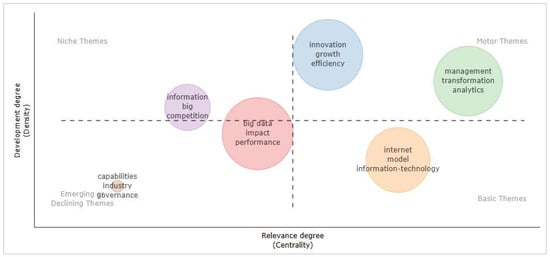
Figure 15.
Thematic map of communities dedicated to big data research in the digital economy.
- Niche themes (top left): one community dedicated to research on information, big, and competition.
- Motor themes (top right): two communities engaged in research on (1) management, transformation, and analytics and on (2) innovation, growth, and efficiency.
- Emerging or declining themes (bottom left): two communities focused on (1) big data, impact, and performance within emerging themes and on (2) capabilities, industry, and governance within declining themes.
- Basic themes (bottom right): one community devoted to research on Internet, model, and information technology.
This classification provides insights into the thematic structure and evolving research directions within big data studies in the digital economy. Recent and upcoming studies continue to explore fundamental themes, while emerging and expanding research focuses specifically on the impact and performance of big data in the digital economy.
Over the past 12 years, research on big data’s implications for the digital economy has undergone significant transformation. Figure 16 visually represents this evolution through rectangular shapes arranged from left to right, illustrating the chronological development of various themes. The relationships between keywords are depicted by gray lines connecting differently colored rectangles, highlighting thematic progression.
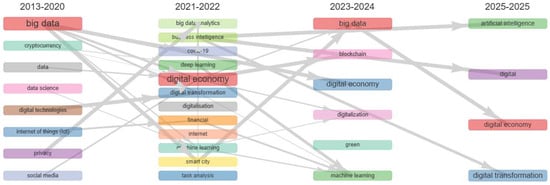
Figure 16.
Thematic evolution of authors’ keywords (Louvain).
By applying the Louvain algorithm and conducting temporal analysis across three-time intervals (2013–2020, 2021–2022, and 2023–2024), we traced the thematic evolution based on authors’ keywords for the year 2025 regarding big data in the digital economy.
The theoretical model of the evolution of big data in the digital economy is structured into five distinct stages, as outlined in Figure 17.
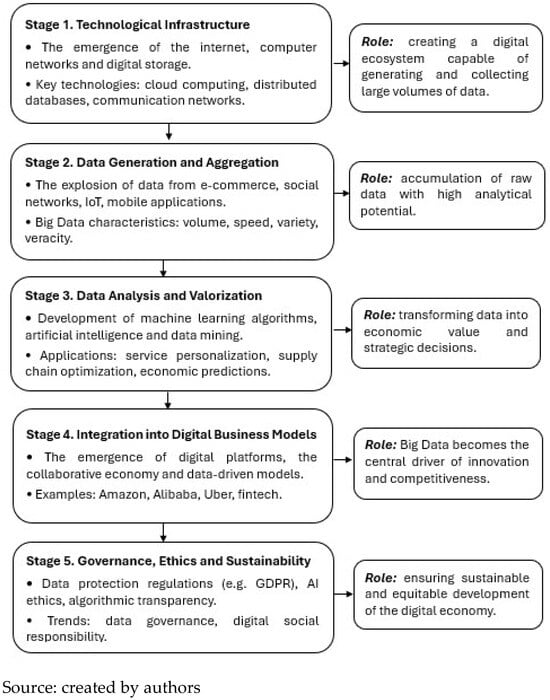
Figure 17.
Theoretical model of the evolution of big data in the digital economy.
This is a concise overview of the development of big data within the digital economy, along with a presentation of its key milestones.
Stage 1: Technological Infrastructure. This stage marks the foundation upon which the entire big data ecosystem was built, spanning roughly from 1995 to 2010, with some significant developments continuing through to around 2012. It laid the groundwork for everything that followed—without a solid infrastructure, neither advanced analytics nor digital business models would have been viable. As demands for speed, scale, and variety increased, this infrastructure evolved to become the backbone of today’s digital economy.
Key milestones from this period include the following:
- 1995–2000: emergence of the commercial Internet and the development of the first scalable relational databases;
- 2003–2004: Google publishes foundational papers on the Google File System and MapReduce, setting the stage for distributed computing [83,84];
- 2006: introduction of Apache Hadoop, enabling efficient storage and processing of massive datasets across server clusters [85];
- 2008–2010: growth of open-source big data ecosystems (e.g., HDFS, Hive, Pig) and early enterprise adoption of distributed solutions [86,87];
- 2010–2012: emergence of scalable cloud services (like Amazon Web Services and Microsoft Azure), making big data infrastructure more accessible [88].
Stage 2: Data Generation and Aggregation. This phase took significant shape between 2005 and 2015, driven by the rapid rise of the Internet, social media platforms, and mobile technologies. It marked a pivotal shift from traditional structured data (such as those found in relational databases) to unstructured and semi-structured formats—ranging from images and videos to free-form text and sensor data streams. It was during this period that volume and variety—two of big data’s five “Vs”—rose to prominence. Key developments from this stage include the following:
- 2005: launch of YouTube, triggering a surge in user-generated multimedia content [89];
- 2006–2010: rapid growth of social networks (e.g., Facebook, Twitter), which became primary sources of unstructured data [90,91];
- 2010–2015: widespread adoption of IoT devices and mobile apps, contributing to a substantial real-time increase in data volume and diversity [92,93,94].
Stage 3: Data Analysis and Valorization. This stage came into full focus between 2012 and 2020, as analytical technologies matured and became deeply embedded in organizational decision-making. It marked a shift from merely collecting data to actively unlocking its value—through predictive models, advanced visualizations, and data-driven strategies. Notable milestones during this phase include the following:
- 2012: the rise of data-driven decision-making, with significant corporate investment in business intelligence and data analytics tools [80,95,96];
- 2014–2016: emergence and consolidation of platforms like Apache Spark 2.0.0, enabling real-time big data processing at scale [97,98];
- 2016–2020: integration of artificial intelligence and machine learning into analytics workflows, driving large-scale prediction, automation, and personalization [99,100,101].
Stage 4: Integration into Digital Business Models. This phase began to take clear shape from 2015 onward, as companies shifted from using big data solely for internal analysis to reimagining their entire business models around it. This stage represents the moment when big data evolved from being just a tool to becoming the very core of value creation. Key developments during this period include the following:
- 2015–2017: Digital platforms like Amazon, Uber, Airbnb, and Alibaba began leveraging data not just for operational efficiency, but as a central component of their customer value proposition [102,103].
- 2018–2020: This period saw the emergence of business models centered on data monetization, the platform economy, and real-time personalized services [102,104].
- 2020–present: The integration of technologies such as AI, blockchain, and edge computing into digital operations has cemented big data as a strategic asset. Companies are transforming into “data-native” enterprises, while traditional models give way to fully digital ecosystems [105,106,107,108,109].
Stage 5: Governance, Ethics, and Sustainability. This phase started to crystallize around 2020 and has been continuously evolving as awareness grows around digital responsibility, data privacy, and the wider societal impact of big data technologies. It reflects a shift from focusing on what we can do with data to considering what we should do with it, placing emphasis on accountability, transparency, and fairness. Key developments during this period include the following:
- 2020–2022: growing debates around AI ethics, algorithmic transparency, and bias in predictive models [110,111,112,113];
- 2022–2023: reinforcement of the European regulatory framework through measures such as the Digital Services Act, the AI Act, and expanded enforcement of the GDPR [114,115,116];
- 2024–2025: implementation of the Corporate Sustainability Reporting Directive (CSRD) into national legislation introducing phased requirements for corporate sustainability reporting, incorporating ESG (Environmental, Social, and Governance) principles into business strategies and big data analytics models [117,118,119,120].
Based on the presented predictions, the integration of quantum computing, decentralized data networks, and AI-based automation will continue to impact the future of big data in the digital economy by innovation, shaping industries, stimulating economic growth, and creating new opportunities for companies and policymakers. This future is promising due to advances in artificial intelligence, blockchain, and machine learning that contribute substantially to improving data processing capabilities.
4.3. Future Research Perspectives on the Implications of Big Data on the Global Digital Economy
Figure 18 illustrates future trends in big data’s implications for the digital economy, as well as its connections to other fields and areas of interest. The size of the bubbles in the graph indicates the frequency of topic occurrences, with big data appearing most frequently (155 times), followed by innovation (75 times), impact (57 times), and management (55 times). Additional topics, such as the Internet, model, future, technologies, framework, and challenges, further complement these discussions. This topic will undoubtedly continue to be a central point in specialist debates.
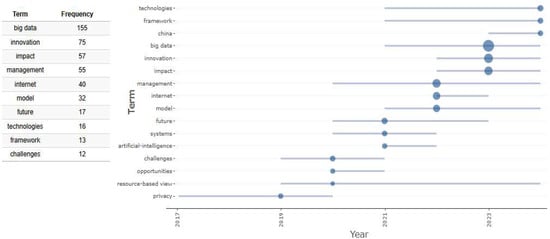
Figure 18.
Future trends of big data in the digital economy and frequencies of the terms.
Figure 18 also presents co-occurrence network maps that highlight current trending topics and emerging research directions concerning big data’s impact on the global digital economy. These topics are systematically organized by domain and publication date, providing a structured view of thematic developments. The selected keywords suggest that big data, innovation, and impact are closely associated with big data’s implications for the digital economy. Given the nuances of these associations, the discussion of hot topics is limited to the first three keywords presented below.
Big data: Between 2025 and 2030, big data will evolve into the backbone of the global digital economy. From streamlining industrial operations to tailoring consumer experiences, data are reshaping how businesses, governments, and individuals engage with technology—and with one another [121]. In this rapidly shifting landscape, China has emerged as a central force, cementing its role as a global leader in leveraging data for economic growth, innovation, and geopolitical influence. With its expansive digital infrastructure, forward-looking policies, and international ambitions, China is not just participating in the data revolution—it is driving it. This progress comes with challenges. The coming years will test the world’s ability to address critical issues such as data security, AI ethics, and digital sovereignty. As the race for big data dominance intensifies, international cooperation will become increasingly vital [122].
Innovation: Big data is no longer a passing trend—it is the fuel powering the next wave of economic transformation. Success in the digital economy of 2025–2030 will hinge on how effectively organizations integrate data into their operations, invest in digital skills, and navigate the complex ethical and societal dimensions of this new era. In a world where data are the new “digital oil,” the ability to collect, analyze, and harness vast volumes of information is becoming essential for competitiveness and progress [123]. During this period, the focus is shifting from merely accumulating data to extracting real-time value from it.
Artificial intelligence and machine learning algorithms are growing increasingly advanced, enabling companies to anticipate consumer behavior, streamline supply chains, and develop highly personalized products. Innovation is no longer a siloed endeavor—it is a direct outcome of predictive analytics and intelligent automation [124]. Between 2025 and 2030, European and international regulations will play a pivotal role in striking a balance between innovation and accountability. Big data is no longer just a technological asset—it is the invisible infrastructure powering innovation, efficiency, and competitiveness across the digital economy. Ultimately, success in this era will belong to those who can turn data into smart decisions, invest in human capital, and build resilient, sustainable digital ecosystems [122].
Impact: According to the European Commission’s State of the Digital Decade 2025 report [125], the adoption of big data, artificial intelligence, and cloud computing is on the rise but must accelerate significantly to meet the EU’s 2030 targets. At the same time, the report underscores persistent challenges, including fragmented digital markets, a shortage of advanced digital skills, and strategic dependencies that hinder innovation. Governments across the EU are increasingly embracing data-driven policies to enhance public services, combat fraud, and better anticipate citizens’ needs. However, a substantial portion of the Union’s governmental digital infrastructure still relies on providers based outside the EU, raising critical concerns about digital sovereignty [126,127]. Between 2025 and 2030, big data will no longer be a mere competitive edge—it will be a fundamental requirement for survival and growth in the digital economy. The economic and institutional players that succeed in leveraging data responsibly, investing in human capital, and building resilient digital ecosystems will be the ones shaping the future.
Based on the arguments presented in Section 4.1, Section 4.2 and Section 4.3, we conclude that research question RQ2 has been thoroughly addressed.
5. Conclusions
5.1. General Conclusions
The aim of this study was to investigate and analyze the evolution and prospective directions of big data applications within the global digital economy over the past two years. Through a comprehensive bibliometric analysis, answers were found to the two proposed research questions, and the results were presented in the previous section. We believe that this bibliometric analysis contributes to the structuring and contextualization of big data in ways that are meaningful for economic growth, innovation, and strategic foresight. It is no longer about big data but about the intelligent use of data. Bibliometric analyses provide the digital economy with this superpower, transforming content chaos into a roadmap for innovation, progress, and sustainable digital transformation. The overall conclusions indicate that China holds a leading global position in scientific research, contributing 430 articles (57.20% of the total) and 7140 citations (representing 74.68% of the worldwide total) in the field of big data and its applications within the digital economy. This prominence is driven by many authors and researchers from prestigious institutions such as the University of the Chinese Academy of Sciences, Shenzhen University, and Guizhou University. China’s leadership is further demonstrated by its extensive network of collaborations, both nationally and internationally, with countries including the United Kingdom, Israel, and Iraq. Moreover, “China” ranks among the top three keywords identified through trend analysis in the context of big data and the digital economy—highlighting the country’s exceptional commitment to technological development in this domain, both now and in the foreseeable future. China is the primary driving force and key player in reshaping the digital economy through big data, a role that is expected to contribute to global technological advancement in the future.
5.2. Theoretical and Practical Contributions
Our bibliometric study on the applicability of big data in the digital economy may support future researchers in (1) identifying the most active authors, journals, countries, and research institutions; (2) examining key areas of scholarly interest and forecasting global research trends regarding the applicability of big data, as well as related research domains and patterns of national and international collaboration; and (3) developing the conceptual framework of big data within the context of the digital economy.
The findings of this bibliometric study may assist researchers by (1) providing insights into various emerging themes previously examined in big data research within the digital economy through bibliometric analysis; (2) enabling exploration of a broader range of application areas by employing alternative tools and technologies for big data; and (3) encouraging practitioners and firms to increase investment in big data tools and technologies to identify and address complex business challenges with robust solutions, gain competitive advantages, and ensure sustained organizational growth.
5.3. Limitations of This Study and Future Research Directions
Nevertheless, this study also presents certain limitations, specifically, (1) the exclusive reliance on the Web of Science (WoS) database and (2) the use of a sample comprising 752 articles, which we consider to be the most representative globally in terms of contributions from researchers indexed in this leading database.
From our perspective, future research should aim to expand the data sources by incorporating or combining additional databases—such as Scopus or Dimensions—to better capture the evolution and global impact of big data applications. To complete the picture provided by Scopus and Dimensions, comprehensive triangulation can be carried out by incorporating additional sources such as Web of Science or Google Scholar. This approach helps validate conclusions and enhances the robustness of the research. Scopus offers more rigorous coverage in the exact sciences and engineering, while Dimensions provides broader access to publications in emerging fields and open-access sources. This allows researchers to (1) compare indicators such as citation counts, impact factors, or co-authorship networks for the same articles or authors across both databases; (2) identify potential biases or differences in visibility between platforms; (3) extract dominant themes (e.g., data security, IoT, cloud computing) and assess their consistency across Scopus and Dimensions; and (4) analyze differences in scientific output between regions or institutions (e.g., the US vs. China) and correlate them with digital policies or investments in digital infrastructure.
Author Contributions
Conceptualization, S.C. and C.-M.B.; methodology, S.C.; software, S.C.; validation, A.-G.S., C.-M.B. and I.-S.R.; formal analysis, A.-G.S.; investigation, I.-S.R.; resources, C.-M.B.; data curation, A.-G.S.; writing—original draft preparation, S.C.; writing—review and editing, S.C.; visualization, C.-M.B.; supervision, A.-G.S. All authors have read and agreed to the published version of the manuscript.
Funding
This research received no external funding.
Data Availability Statement
Data are contained within the article.
Conflicts of Interest
The authors declare no conflicts of interest.
References
- Javaid, M.; Haleem, A.; Singh, R.P.; Sinha, A.K. Digital economy to improve the culture of industry 4.0: A study on features, implementation and challenges. Green Technol. Sustain. 2024, 2, 100083. [Google Scholar] [CrossRef]
- Samsul, S.A.; Yahaya, N.; Abuhassna, H. Education big data and learning analytics: A bibliometric analysis. Humanit. Soc. Sci. Commun. 2023, 10, 709. [Google Scholar] [CrossRef]
- Erümit, A.K.; Cebeci, H.Y.; Özmen, S. Big Data in Higher Education: Bibliometric Analysis. TechTrends 2024, 68, 1129–1139. [Google Scholar] [CrossRef]
- Liao, H.; Tang, M.; Luo, L.; Li, C.; Chiclana, F.; Zeng, X.-J. A bibliometric analysis and visualization of medical big data research. Sustainability 2018, 10, 166. [Google Scholar] [CrossRef]
- Li, B.; Du, K.; Qu, G.; Tang, N. Big data research in nursing: A bibliometric exploration of themes and publications. J. Nurs. Scholarsh. 2024, 56, 466–477. [Google Scholar] [CrossRef]
- Nobanee, H. A Bibliometric Review of Big Data in Finance. Big Data 2021, 9, 73–78. [Google Scholar] [CrossRef]
- Ar-Raisi, F.A.; Sakti, E.; Anggono, A.; Tarjo, T. Bibliometric Analysis of Big Data Research in Finance. J. Magister Akunt. Trisakti 2023, 10, 1–18. [Google Scholar] [CrossRef]
- Ardito, L.; Scuotto, V.; Del Giudice, M.; Petruzzelli, A.M. A bibliometric analysis of research on Big Data analytics for business and management. Manag. Decis. 2019, 57, 1993–2009. [Google Scholar] [CrossRef]
- Nobanee, H. Big Data in Business: A Bibliometric Analysis of Relevant Literature. Big Data 2020, 8, 459–463. [Google Scholar] [CrossRef]
- Sahoo, S. Big data analytics in manufacturing: A bibliometric analysis of research in the field of business management. Int. J. Prod. Res. 2021, 60, 6793–6821. [Google Scholar] [CrossRef]
- Gao, W.; Qiu, Q.; Yuan, C.; Shen, X.; Cao, F.; Wang, G.; Wang, G. Forestry Big Data: A Review and Bibliometric Analysis. Forests 2022, 13, 1549. [Google Scholar] [CrossRef]
- Islam, N.; Hu, G.; Ashiq, M.; Ahmad, S. Exploring the landscape of big data applications in librarianship: A bibliometric analysis of research trends and patterns. Libr. Hi Tech 2025, 43, 872–895. [Google Scholar] [CrossRef]
- Wang, L.; Pertheban, T.R.A.L.; Li, T.; Zhao, L. Application of business intelligence based on big data in E-commerce data evaluation. Heliyon 2024, 10, e38768. [Google Scholar] [CrossRef]
- Akter, S.; Wamba, S.F. Big data analytics in e-commerce: A systematic review and agenda for future research. Electron. Mark. 2016, 26, 173–194. [Google Scholar] [CrossRef]
- Tzika-Kostopoulou, D.; Nathanail, E.; Kokkinos, K. Big data in transportation: A systematic literature analysis and topic classification. Knowl. Inf. Syst. 2024, 66, 5021–5046. [Google Scholar] [CrossRef]
- Zhuang, Y.; Cenci, J.; Zhang, J. Review of Big Data Implementation and Expectations in Smart Cities. Buildings 2024, 14, 3717. [Google Scholar] [CrossRef]
- Abdelrahman, Y.; Hajek, P.; Lubica, H. Research trends in the application of big data in smart cities—A literature review. Can. J. Adm. Stud. 2023, 40, 254–269. [Google Scholar] [CrossRef]
- Gu, D.; Li, J.; Li, X.; Liang, C. Visualizing the knowledge structure and evolution of big data research in healthcare informatics. Int. J. Med. Inform. 2017, 98, 22–32. [Google Scholar] [CrossRef]
- Raban, D.R.; Gordon, A. The evolution of data science and big data research: A bibliometric analysis. Scientometrics 2020, 122, 1563–1581. [Google Scholar] [CrossRef]
- Bilgili, E.C.G.; Yılmaz, A.A. The Big Data Revolution: A Comprehensive Bibliometric Study on Management and Organizational Development with a Focus on Web of Science. Korkut Ata Türk. Araşt. Derg. 2024, 16, 328–356. [Google Scholar] [CrossRef]
- Juliardi, M.; Malik, I. A Bibliometric Analysis of Data Science: Trends, Contributions, and Research Developments. West Sci. Interdiscip. Stud. 2023, 1, 387–397. Available online: https://scispace.com/pdf/bibliometric-analysis-of-data-science-trends-contributions-tk775qbvfe.pdf (accessed on 15 May 2025).
- Lundberg, L. Bibliometric mining of research directions and trends for big data. J. Big Data 2023, 10, 112. [Google Scholar] [CrossRef]
- Raghuramapatruni, R. Trends and Pattern in Big Data: A Bibliometric Study. Int. J. Intell. Syst. Appl. Eng. 2024, 12, 322–333. Available online: https://ijisae.org/index.php/IJISAE/article/view/4599 (accessed on 16 May 2025).
- Islam, N.; Hu, G. An Insight into the State of Big Data Research: A Bibliometric Study of Scientific Publications. Sci. Technol. Libr. 2023, 43, 31–51. [Google Scholar] [CrossRef]
- Zhang, Y.; Zhang, M.; Li, J.; Liu, G.; Yang, M.M.; Liu, S. A bibliometric review of a decade of research: Big data in business research—Setting a research agenda. J. Bus. Res. 2021, 131, 374–390. [Google Scholar] [CrossRef]
- Xu, Z.; Yu, D. A Bibliometrics analysis on big data research (2009–2018). J. Data Inf. Manag. 2019, 1, 3–15. [Google Scholar] [CrossRef]
- Inamdar, Z.; Raut, R.; Narwane, V.S.; Gardas, B.; Narkhede, B.; Sagnak, M. A systematic literature review with bibliometric analysis of big data analytics adoption from period 2014 to 2018. J. Enterp. Inf. Manag. 2021, 34, 101–139. [Google Scholar] [CrossRef]
- Chavez, H.; Albornoz, M.B.; Martín, F. Big data Research: A Bibliometric Analysis of the Scopus Database, 2009–2019. J. Scientometr. Res. 2022, 11, 64–78. [Google Scholar] [CrossRef]
- Abdian, S.; Shahri, M.H.; Khadivar, A. A Bibliometric Analysis of Research on Big Data and Its Potential to Value Creation and Capture. Interdiscip. J. Manag. Stud. 2023, 16, 1–24. [Google Scholar] [CrossRef]
- Hu, J.; Zhang, Y. Discovering the interdisciplinary nature of big data research through social network analysis and visualization. Scientometrics 2017, 112, 91–109. [Google Scholar] [CrossRef]
- Kuc-Czarnecka, M.; Olczyk, M. How ethics combine with big data: A bibliometric analysis. Humanit. Soc. Sci. Commun. 2020, 7, 137. [Google Scholar] [CrossRef]
- Mishra, D.; Gunasekaran, A.; Papadopoulos, T.; Childe, S.J. Big Data and supply chain management: A review and bibliometric analysis. Ann. Oper. Res. 2018, 270, 313–336. [Google Scholar] [CrossRef]
- Al-Sartawi, A.M.A.M. The Big Data-Driven Digital Economy: Artificial and Computational Intelligence; Springer: Cham, Switzerland, 2021; Available online: https://link.springer.com/book/10.1007/978-3-030-73057-4 (accessed on 1 July 2025).
- Xia, Y.; Lv, G.; Wang, H.; Ding, L. Evolution of digital economy research: A bibliometric analysis. Int. Rev. Econ. Financ. 2023, 88, 1151–1172. [Google Scholar] [CrossRef]
- Zeng, S.; Yang, H. A Bibliometric and Visualization Analysis of Knowledge Mapping in Digital Economy Research, 1992–2022. Sustainability 2023, 15, 6565. [Google Scholar] [CrossRef]
- Yuan, Z. Analysis and research of digital economy based on the background of big data. In Proceedings of the International Conference on Digital Economy and Management Science (CDEMS 2023), Kaifeng, China, 21–23 April 2023; Volume 170, p. 01016. [Google Scholar] [CrossRef]
- Bogoviz, A.V. Big Data in Information Society and Digital Economy; Springer: Cham, Switzerland, 2023; Available online: https://link.springer.com/book/10.1007/978-3-031-29489-1 (accessed on 25 May 2025).
- Zherlitsyn, D.; Kolarov, K.; Rekova, N. Digital Transformation in the EU: Bibliometric Analysis and Digital Economy Trends Highlights. Digital 2025, 5, 1. [Google Scholar] [CrossRef]
- Mougenot, B.; Doussoulin, J.P. Conceptual evolution of the bioeconomy: A bibliometric analysis. Environ. Dev. Sustain. 2022, 24, 1031–1047. [Google Scholar] [CrossRef]
- Moral-Muñoz, J.A.; Herrera-Viedma, E.; Santisteban-Espejo, A.; Cobo, M.J. Software tools for conducting bibliometric analysis in science: An up-to-date review. Prof. Inf. 2020, 29, 4. [Google Scholar] [CrossRef]
- Goldfarb, A.; Tucker, C. Digital Economics. J. Econ. Lit. 2019, 57, 3–43. [Google Scholar] [CrossRef]
- Hampton, S.E.; Strasser, C.A.; Tewksbury, J.J.; Gram, W.K.; Budden, A.E.; Batcheller, A.L.; Duke, C.S.; Porter, J.H. Big data and the future of ecology. Front. Ecol. Environ. 2013, 11, 156–162. [Google Scholar] [CrossRef]
- Ma, D.; Zhu, Q. Innovation in emerging economies: Research on the digital economy driving high-quality green development. J. Bus. Res. 2022, 145, 801–813. [Google Scholar] [CrossRef]
- Shin, D.-H.; Choi, M.-J. Ecological Views of Big Data: Perspectives and Issues. Telemat. Inform. 2015, 32, 311–320. [Google Scholar] [CrossRef]
- Zhang, W.; Liu, X.; Wang, D.; Zhou, J. Digital economy and carbon emission performance: Evidence at China’s city level. Energy Policy 2022, 165, 112927. [Google Scholar] [CrossRef]
- McAfee, A.; Brynjolfsson, E.; Davenport, T.H.; Patil, D.J.; Barton, D. Big data: The management revolution. Harv. Bus. Rev. 2012, 90, 61–67. Available online: https://harrt.ucla.edu/wp-content/uploads/2015/12/Big-Data-The-Management-Revolution-.pdf (accessed on 20 May 2025).
- Nambisan, S.; Lyytinen, K.; Majchrzak, A.; Song, M. Digital Innovation Management: Reinventing Innovation Management Research in a Digital World. MIS Q. 2017, 41, 223–238. [Google Scholar] [CrossRef]
- Boyd, D.; Crawford, K. Critical Questions for Big Data: Provocations for a cultural, technological, and scholarly phenomenon. Inf. Commun. Soc. 2012, 15, 662–679. [Google Scholar] [CrossRef]
- Gupta, M.; George, J.F. Toward the development of a big data analytics capability. Inf. Manag. 2016, 53, 1049–1064. [Google Scholar] [CrossRef]
- Doherty, A.; Jackson, D.; Hammerla, N.; Plötz, T.; Olivier, P.; Granat, M.H.; Wite, T.; van Hees, V.T.; Trenell, M.I.; Owen, C.G.; et al. Large Scale Population Assessment of Physical Activity Using Wrist Worn Accelerometers: The UK Biobank Study. PLoS ONE 2017, 12, e0169649. [Google Scholar] [CrossRef]
- Li, Z.; Wang, J. The Dynamic Impact of Digital Economy on Carbon Emission Reduction: Evidence City-Level Empirical Data in China. J. Clean. Prod. 2022, 351, 131570. [Google Scholar] [CrossRef]
- Guo, B.; Wang, Y.; Zhang, H.; Liang, C.; Feng, Y.; Hu, F. Impact of the digital economy on high-quality urban economic development: Evidence from Chinese cities. Econ. Model. 2023, 120, 106194. [Google Scholar] [CrossRef]
- Vidgen, R.; Shaw, S.; Grant, D.B. Management challenges in creating value from business analytics. Eur. J. Oper. Res. 2017, 261, 626–639. [Google Scholar] [CrossRef]
- Dong, F.; Hu, M.; Gao, Y.; Liu, Y.; Zhu, J.; Pan, Y. How does digital economy affect carbon emissions? Evidence from global 60 countries. Sci. Total. Environ. 2022, 852, 158401. [Google Scholar] [CrossRef]
- Moll, J.; Yigitbasioglu, O. The role of internet-related technologies in shaping the work of accountants: New directions for accounting research. Br. Account. Rev. 2019, 51, 100833. [Google Scholar] [CrossRef]
- Allam, Z.; Sharifi, A.; Bibri, S.E.; Jones, D.S.; Krogstie, J. The Metaverse as a Virtual Form of Smart Cities: Opportunities and Challenges for Environmental, Economic, and Social Sustainability in Urban Futures. Smart Cities 2022, 5, 771–801. [Google Scholar] [CrossRef]
- Xu, Z.; Frankwick, G.L.; Ramirez, E. Effects of big data analytics and traditional marketing analytics on new product success: A knowledge fusion perspective. J. Bus. Res. 2016, 69, 1562–1566. [Google Scholar] [CrossRef]
- Ren, S.; Li, L.; Han, Y.; Hao, Y.; Wu, H. The emerging driving force of inclusive green growth: Does digital economy agglomeration work? Bus. Strategy Environ. 2022, 31, 1656–1678. [Google Scholar] [CrossRef]
- Manesh, M.F.; Pellegrini, M.M.; Marzi, G.; Dabic, M. Knowledge Management in the Fourth Industrial Revolution: Mapping the Literature and Scoping Future Avenues. IEEE Trans. Eng. Manag. 2021, 68, 289–300. [Google Scholar] [CrossRef]
- Newlands, G. Algorithmic Surveillance in the Gig Economy: The Organization of Work through Lefebvrian Conceived Space. Organ. Stud. 2021, 42, 719–737. [Google Scholar] [CrossRef]
- Yang, P.; Xiong, N.; Ren, J. Data Security and Privacy Protection for Cloud Storage: A Survey. IEEE Access 2020, 8, 131723–131740. [Google Scholar] [CrossRef]
- Yang, Q.; Zhao, Y.; Huang, H.; Xiong, Z.; Kang, J.; Zheng, Z. Fusing Blockchain and AI With Metaverse: A Survey. IEEE Open J. Comput. Soc. 2022, 3, 122–136. [Google Scholar] [CrossRef]
- Arts, K.; van der Wal, R.; Adams, W.M. Digital technology and the conservation of nature. Ambio 2015, 44, 661–673. [Google Scholar] [CrossRef]
- Cheng, Y.; Zhang, Y.; Wang, J.; Jiang, J. The impact of the urban digital economy on China’s carbon intensity: Spatial spillover and mediating effect. Resour. Conserv. Recycl. 2023, 189, 106762. [Google Scholar] [CrossRef]
- Hu, J. Synergistic effect of pollution reduction and carbon emission mitigation in the digital economy. J. Environ. Manag. 2023, 337, 117755. [Google Scholar] [CrossRef]
- Fourcade, M.; Kluttz, D.N. A Maussian bargain: Accumulation by gift in the digital economy. Big Data Soc. 2020, 7. [Google Scholar] [CrossRef]
- Sultana, S.; Akter, S.; Kyriazis, E.; Wamba, S.F. Architecting and Developing Big Data-Driven Innovation (DDI) in the Digital Economy. J. Glob. Inf. Manag. 2021, 29, 165–187. [Google Scholar] [CrossRef]
- Tranos, E.; Kitsos, T.; Ortega-Argilés, R. Digital economy in the UK: Regional productivity effects of early adoption. Reg. Stud. 2020, 55, 1924–1938. [Google Scholar] [CrossRef]
- Nuccio, M.; Guerzoni, M. Big data: Hell or heaven? Digital platforms and market power in the data-driven economy. Compet. Change 2018, 23, 312–328. [Google Scholar] [CrossRef]
- Novikov, S.V. Data Science and Big Data Technologies Role in the Digital Economy. TEM J. 2020, 9, 756–762. [Google Scholar] [CrossRef]
- Liu, Y.; Xie, Y.; Zhong, K. Impact of digital economy on urban sustainable development: Evidence from Chinese cities. Sustain. Dev. 2024, 32, 307–324. [Google Scholar] [CrossRef]
- Nathan, M.; Rosso, A. Mapping digital businesses with big data: Some early findings from the UK. Res. Policy 2015, 44, 1714–1733. [Google Scholar] [CrossRef]
- Newlands, G.; Lutz, C.; Tamò-Larrieux, A.; Villaronga, E.F.; Harasgama, R.; Scheitlin, G. Innovation under pressure: Implications for data privacy during the Covid-19 pandemic. Big Data Soc. 2020, 7. [Google Scholar] [CrossRef]
- Valentine, E.; Stewart, G. The emerging role of the Board of Directors in enterprise business technology governance. Int. J. Discl. Gov. 2013, 10, 346–362. [Google Scholar] [CrossRef]
- Pan, W.; Xie, T.; Wang, Z.; Ma, L. Digital economy: An innovation driver for total factor productivity. J. Bus. Res. 2022, 139, 303–311. [Google Scholar] [CrossRef]
- Baron, R.M.; Kenny, D.A. The moderator–mediator variable distinction in social psychological research: Conceptual, strategic, and statistical considerations. J. Personal. Soc. Psychol. 1986, 51, 1173–1182. [Google Scholar] [CrossRef]
- Tao, Z.; Zhi, Z.; Shangkun, L. Digital Economy, Entrepreneurship, and High-Quality Economic Development: Empirical Evidence from Urban China. Front. Econ. China 2022, 17, 393–426. [Google Scholar] [CrossRef]
- Teece, D.J. Profiting from innovation in the digital economy: Enabling technologies, standards, and licensing models in the wireless world. Res. Policy 2018, 47, 1367–1387. [Google Scholar] [CrossRef]
- Acemoglu, D.; Restrepo, P. The Race between Man and Machine: Implications of Technology for Growth, Factor Shares, and Employment: Dataset. Am. Econ. Rev. 2018, 108, 1488–1542. [Google Scholar] [CrossRef]
- Chen, H.; Chiang, R.H.L.; Storey, V.C. Business Intelligence and Analytics: From Big Data to Big Impact. MIS Q. 2012, 36, 1165–1188. [Google Scholar] [CrossRef]
- Li, Y.; Yang, X.; Ran, Q.; Wu, H.; Irfan, M.; Ahmad, M. Energy structure, digital economy, and carbon emissions: Evidence from China. Environ. Sci. Pollut. Res. 2021, 28, 64606–64629. [Google Scholar] [CrossRef]
- Bukht, R.; Heeks, R. Defining, Conceptualising and Measuring the Digital Economy. Int. Organ. Res. J. 2018, 13, 143–172. [Google Scholar] [CrossRef]
- Ghemawat, S.; Gobioff, H.; Leung, S.-T. The Google File System. Available online: https://static.googleusercontent.com/media/research.google.com/en//archive/gfs-sosp2003.pdf (accessed on 20 May 2025).
- Dean, J.; Ghemawat, S. MapReduce: Simplified Data Processing on Large Clusters. 2004. Available online: https://static.googleusercontent.com/media/research.google.com/en//archive/mapreduce-osdi04.pdf (accessed on 20 May 2025).
- Moise, D.; Shestakov, D. Terabyte-Scale Image Similarity Search. In Handbook of Statistics; Govindaraju, V., Vijay, V.R., Rao, C.R., Eds.; Elsevier: Amsterdam, The Netherlands, 2015; Volume 33, pp. 279–301. [Google Scholar] [CrossRef]
- Yu, J.-H.; Zhou, Z.-M. Components and Development in Big Data System: A Survey. J. Electron. Sci. Technol. 2019, 17, 51–72. [Google Scholar] [CrossRef]
- Landset, S.; Khoshgoftaar, T.M.; Richter, A.N.; Hasanin, T. A survey of open source tools for machine learning with big data in the Hadoop ecosystem. J. Big Data 2015, 2, 24. [Google Scholar] [CrossRef]
- Al-Sayyed, R.M.H.; Hijawi, W.A.; Bashiti, A.M.; AlJarah, I.; Obeid, N.; Al-Adwan, O.Y.A. An Investigation of Microsoft Azure and Amazon Web Services from Users’ Perspectives. Int. J. Emerg. Technol. Learn. 2019, 14, 217–241. [Google Scholar] [CrossRef]
- Holland, M. How YouTube Developed into a Successful Platform for User-Generated Content. Elon J. Undergrad. Res. Commun. 2016, 7. Available online: http://www.inquiriesjournal.com/a?id=1477 (accessed on 15 May 2025).
- Helmond, A.; Nieborg, D.B.; van der Vlist, F.N. Facebook’s evolution: Development of a platform-as-infrastructure. Internet Hist. 2019, 3, 123–146. [Google Scholar] [CrossRef]
- Cano-Marin, E.; Mora-Cantallops, M.; Sánchez-Alonso, S. Twitter as a predictive system: A systematic literature review. J. Bus. Res. 2023, 157, 113561. [Google Scholar] [CrossRef]
- Matekaire, K.; Siriram, R. An overview of factors influencing the adoption of IoT payment systems in South Africa’s small and medium-sized retail enterprises. J. Open Innov. Technol. Mark. Complex. 2025, 11, 100566. [Google Scholar] [CrossRef]
- Brous, P.; Janssen, M.; Herder, P. The dual effects of the Internet of Things (IoT): A systematic review of the benefits and risks of IoT adoption by organizations. Int. J. Inf. Manag. 2020, 51, 101952. [Google Scholar] [CrossRef]
- Chataut, R.; Phoummalayvane, A.; Akl, R. Unleashing the Power of IoT: A Comprehensive Review of IoT Applications and Future Prospects in Healthcare, Agriculture, Smart Homes, Smart Cities, and Industry 4.0. Sensors 2023, 23, 7194. [Google Scholar] [CrossRef]
- Korherr, P.; Kanbach, D.K.; Kraus, S.; Mikalef, P. From intuitive to data-driven decision-making in digital transformation: A framework of prevalent managerial archetypes. Digit. Bus. 2022, 2, 100045. [Google Scholar] [CrossRef]
- Szukits, Á.; Móricz, P. Towards data-driven decision making: The role of analytical culture and centralization efforts. Rev. Manag. Sci. 2023, 18, 2849–2887. [Google Scholar] [CrossRef]
- Zaharia, M.; Xin, R.S.; Wendell, P.; Das, T.; Armbrust, M.; Dave, A.; Meng, X.; Rosen, J.; Venkataraman, S.; Franklin, M.J.; et al. Apache Spark: A Unified Engine for Big Data Processing. Commun. ACM 2016, 59, 56–65. [Google Scholar] [CrossRef]
- Theodorakopoulos, L.; Karras, A.; Krimpas, G.A. Optimizing Apache Spark MLlib: Predictive Performance of Large-Scale Models for Big Data Analytics. Algorithms 2025, 18, 74. [Google Scholar] [CrossRef]
- Aldoseri, A.; Al-Khalifa, K.N.; Hamouda, A.M. Re-Thinking Data Strategy and Integration for Artificial Intelligence: Concepts, Opportunities, and Challenges. Appl. Sci. 2023, 13, 7082. [Google Scholar] [CrossRef]
- Almanasra, S. Applications of integrating artificial intelligence and big data: A comprehensive analysis. J. Intell. Syst. 2024, 33, 20240237. [Google Scholar] [CrossRef]
- Yaiprasert, C.; Hidayanto, A.N. AI-driven ensemble three machine learning to enhance digital marketing strategies in the food delivery business. Intell. Syst. Appl. 2023, 18, 200235. [Google Scholar] [CrossRef]
- Zhao, Y.; von Delft, S.; Morgan-Thomas, A.; Buck, T. The evolution of platform business models: Exploring competitive battles in the world of platforms. Long Range Plan. 2020, 53, 101892. [Google Scholar] [CrossRef]
- Gawer, A. Digital platforms’ boundaries: The interplay of firm scope, platform sides, and digital interfaces. Long Range Plan. 2021, 54, 102045. [Google Scholar] [CrossRef]
- Ofulue, J.; Benyoucef, M. Data monetization: Insights from a technology-enabled literature review and research agenda. Manag. Rev. Q. 2024, 74, 521–565. [Google Scholar] [CrossRef]
- Nguyen, T.; Nguyen, H.; Gia, T.N. Exploring the integration of edge computing and blockchain IoT: Principles, architectures, security, and applications. J. Netw. Comput. Appl. 2024, 226, 103884. [Google Scholar] [CrossRef]
- Zhu, J.; Li, F.; Chen, J. A survey of blockchain, artificial intelligence, and edge computing for Web 3.0. Comput. Sci. Rev. 2024, 54, 100667. [Google Scholar] [CrossRef]
- Ficili, I.; Giacobbe, M.; Tricomi, G.; Puliafito, A. From Sensors to Data Intelligence: Leveraging IoT, Cloud, and Edge Computing with AI. Sensors 2025, 25, 1763. [Google Scholar] [CrossRef]
- Asaithambi, S.; Nallusamy, S.; Yang, J.; Prajapat, S.; Kumar, G.; Rathore, P.S. A secure and trustworthy blockchain-assisted edge computing architecture for industrial internet of things. Sci. Rep. 2025, 15, 15410. [Google Scholar] [CrossRef]
- Kumar, S.; Lim, W.M.; Sivarajah, U.; Kaur, J. Artificial Intelligence and Blockchain Integration in Business: Trends from a Bibliometric-Content Analysis. Inf. Syst. Front. 2023, 25, 871–896. [Google Scholar] [CrossRef]
- Murikah, W.; Nthenge, J.K.; Musyoka, F.M. Bias and ethics of AI systems applied in auditing-A systematic review. Sci. Afr. 2024, 25, e02281. [Google Scholar] [CrossRef]
- Radanliev, P. AI Ethics: Integrating Transparency, Fairness, and Privacy in AI Development. Appl. Artif. Intell. 2025, 39. [Google Scholar] [CrossRef]
- Ferrara, E. Fairness and Bias in Artificial Intelligence: A Brief Survey of Sources, Impacts, and Mitigation Strategies. Science 2024, 6, 3. [Google Scholar] [CrossRef]
- Belenguer, L. AI bias: Exploring discriminatory algorithmic decision-making models and the application of possible machine-centric solutions adapted from the pharmaceutical industry. AI Ethics 2022, 2, 771–787. [Google Scholar] [CrossRef]
- Montagnani, M.L.; Najjar, M.-C.; Davola, A. The EU Regulatory approach(es) to AI liability, and its Application to the financial services market. Comput. Law Secur. Rev. 2024, 53, 105984. [Google Scholar] [CrossRef]
- Bogucki, A.; Engler, A.; Perarnaud, C.; Renda, A. The AI Act and Emerging EU Digital Acquis. Overlaps, Gaps and Inconsistencies; CEPS: Brussels, Belgium, 2022; Available online: https://cdn.ceps.eu/wp-content/uploads/2022/09/CEPS-In-depth-analysis-2022-02_The-AI-Act-and-emerging-EU-digital-acquis.pdf (accessed on 24 June 2025).
- Nannini, L.; Bonel, E.; Bassi, D.; Maggini, M.J. Beyond phase-in: Assessing impacts on disinformation of the EU Digital Services Act. AI Ethics 2025, 5, 1241–1269. [Google Scholar] [CrossRef]
- Hummel, K.; Jobst, D. An Overview of Corporate Sustainability Reporting Legislation in the European Union. Account. Eur. 2024, 21, 320–355. [Google Scholar] [CrossRef]
- Lim, T. Environmental, social, and governance (ESG) and artificial intelligence in finance: State-of-the-art and research takeaways. Artif. Intell. Rev. 2024, 57, 76. [Google Scholar] [CrossRef]
- Shmelev, S.E.; Gilardi, E. Corporate Environmental, Social, and Governance Performance: The Impacts on Financial Returns, Business Model Innovation, and Social Transformation. Sustainability 2025, 17, 1286. [Google Scholar] [CrossRef]
- Abdelhalim, A.M.; Hassan, M. Exploring the impact of big data analytics and risk management convergence on sustainability performance development: An accounting perspective. Discov. Sustain. 2025, 6, 175. [Google Scholar] [CrossRef]
- Vărzaru, A.A.; Bocean, C.G. Digital Transformation and Innovation: The Influence of Digital Technologies on Turnover from Innovation Activities and Types of Innovation. Systems 2024, 12, 359. [Google Scholar] [CrossRef]
- Schmid, S.; Lambach, D.; Diehl, C.; Reuter, C. Arms Race or Innovation Race? Geopolitical AI Development. Geopolitics 2025, 30, 1907–1936. [Google Scholar] [CrossRef]
- Yi, X.; Liu, F.; Liu, J.; Jin, H. Building a network highway for big data: Architecture and challenges. IEEE Netw. 2014, 28, 5–13. [Google Scholar] [CrossRef]
- Aldoseri, A.; Al-Khalifa, K.N.; Hamouda, A.M. AI-Powered Innovation in Digital Transformation: Key Pillars and Industry Impact. Sustainability 2024, 16, 1790. [Google Scholar] [CrossRef]
- EU. State of the Digital Decade Package. 2025. Available online: https://digital-strategy.ec.europa.eu/en/policies/2025-state-digital-decade-package (accessed on 25 June 2025).
- Musoni, M.; Karkare, P.; Teevan, C.; Domingo, E. Global Approaches to Digital Sovereignty: Competing Definitions and Contrasting Policy; ECDPM: Maastricht, The Netherlands, 2023; Available online: https://ecdpm.org/application/files/7816/8485/0476/Global-approaches-digital-sovereignty-competing-definitions-contrasting-policy-ECDPM-Discussion-Paper-344-2023.pdf (accessed on 25 June 2025).
- Burwell, F.; Propp, K. Digital Sovereignty in Practice: The EU’s Push to Shape the New Global Economy; Atlantic Council: Washington, DC, USA, 2022; Available online: https://www.atlanticcouncil.org/in-depth-research-reports/report/digital-sovereignty-in-practice-the-eus-push-to-shape-the-new-global-economy/ (accessed on 25 June 2025).
Disclaimer/Publisher’s Note: The statements, opinions and data contained in all publications are solely those of the individual author(s) and contributor(s) and not of MDPI and/or the editor(s). MDPI and/or the editor(s) disclaim responsibility for any injury to people or property resulting from any ideas, methods, instructions or products referred to in the content. |
© 2025 by the authors. Licensee MDPI, Basel, Switzerland. This article is an open access article distributed under the terms and conditions of the Creative Commons Attribution (CC BY) license (https://creativecommons.org/licenses/by/4.0/).